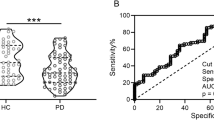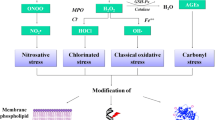Abstract
Purpose
Chronic renal failure patients undergoing peritoneal dialysis (PD) are characterized by increased oxidative stress (OS), which is associated with enhanced cardiovascular risk. Moreover, oxidative stress also contributes to peritoneal membrane changes and ultrafiltration failure. The aim of this study was to evaluate OS in PD patients and the effect of treatment with ascorbic acid and α-tocopherol.
Methods
Plasma, erythrocyte, urine, and peritoneal effluent samples from 20 patients on PD were evaluated for glutathione peroxidase and superoxide dismutase activity, total antioxidant capacity (TAC) and malondialdehyde (MDA) levels, as well as protein carbonyl formation, before and after administration of vitamin C, alone or in combination with vitamin E, in comparison with 10 apparently healthy control individuals.
Results
All studied markers showed enhanced OS in the PD group, compared to controls. The supplementation of vitamin C and E resulted in improvements of all the OS markers, as indicated by increased erythrocyte antioxidant enzymes activity and TAC levels, as well as decreased MDA concentration and carbonyl compound formation.
Conclusions
The oral supplementation of antioxidant vitamins C and E, in combination, can lead to decreased OS, thus providing a useful and cost-effective therapeutic option in PD patients.


Similar content being viewed by others
References
Vanholder R, Massy Z, Argiles A et al (2005) Chronic kidney disease as cause of cardiovascular morbidity and mortality. Nephrol Dial Transplant 20:1048–1056
Van Biesen W, De Bacquer D, Verbeke F et al (2007) The glomerular filtration rate in an apparently healthy population and its relation with cardiovascular mortality during 10 years. Eur Heart J 28:478–483
Fried LF, Shlipak MG, Crump C et al (2003) Renal insufficiency as a predictor of cardiovascular outcomes and mortality in elderly individuals. J Am Coll Cardiol 41:1364–1372
Kocak H, Gumuslu S, Ermis C et al (2008) Oxidative stress and asymmetric dimethylarginine is independently associated with carotid intima media thickness in peritoneal dialysis patients. Am J Nephrol 28:91–96
Arima H, Nakamoto H, Okada S et al (2006) Risk factors for vascular complications in patients on peritoneal dialysis. Adv Perit Dial 22:192–197
Pecoits-Filho R, Lindholm B, Stenvinkel P (2002) The malnutrition, inflammation, and atherosclerosis (MIA) syndrome—the heart of the matter. Nephrol Dial Transplant 11:28–31
Sahin E, Göçmen AY, Koçak H (2008) The association of advanced glycation end-products with glutathione status. Ann Clin Biochem 45:369–374
Del Vecchio L, Locatelli F, Carini M (2011) What we know about oxidative stress in patients with chronic kidney disease on dialysis—clinical effects, potential treatment, and prevention. Semin Dial 24:56–64
Dursun B, Dursun E, Capraz I et al (2008) Are uremia, diabetes, and atherosclerosis linked with impaired antioxidant mechanisms? J Investig Med 56:545–552
Honda K, Nitta K, Horita S et al (1999) Accumulation of advanced glycation end products in the peritoneal vasculature of continuous ambulatory peritoneal dialysis patients with low ultra-filtration. Nephrol Dial Transplant 14:1541–1549
Kaneko K, Hamada C, Tomino Y (2007) Peritoneal fibrosis intervention. Perit Dial Int Suppl 2:S82–S86
Niwa T, Tsukushi S (2001) 3-deoxyglucosone and AGEs in uremic complications: inactivation of glutathione peroxidase by 3-deoxyglucosone. Kidney Int 78:S37–S41
De Vriese AS, Tilton RG, Mortier S et al (2006) Myofibroblast transdifferentiation of mesothelial cells is mediated by RAGE and contributes to peritoneal fibrosis in uraemia. Nephrol Dial Transplant 21:2549–2555
Noh H, Kim JS, Han KH et al (2006) Oxidative stress during peritoneal dialysis: implications in functional and structural changes in the membrane. Kidney Int 69:2022–2028
Gotloib L (2009) Mechanisms of cell death during peritoneal dialysis. A role for osmotic and oxidative stress. Contrib Nephrol 163:35–44
Lonn E, Yusuf S, Hoogwerf B et al (2002) HOPE Study; MICRO-HOPE study effects of vitamin E on cardiovascular and microvascular outcomes in high-risk patients with diabetes: results of the HOPE study and MICRO-HOPE substudy. Diabetes Care 25:1919–1927
Riccioni G, Frigiola A, Pasquale S et al (2012) Vitamin C and E consumption and coronary heart disease in men. Front Biosci (Elite Ed) 4:373–380
Chen AF, Chen DD, Daiber A et al (2012) Free radical biology of the cardiovascular system. Clin Sci (Lond) 123:73–91
Coombes JS, Fassett RG (2012) Antioxidant therapy in hemodialysis patients: a systematic review. Kidney Int 81:233–246
Diepeveen SH, Verhoeven GH, van der Palen J et al (2005) The effect of the initiation of renal replacement therapy on lipid profile and oxidative stress during the first 6 months of treatment. Clin Chim Acta 361:112–118
Cruz DN, Soni SS, Polanco N et al (2010) Markers of inflammation and oxidative stress in peritoneal dialysis: a comparison between high and low peritoneal transporters. J Nephrol 23:453–458
Charalampidis PS, Veltsistas P, Karkabounas S et al (2009) Blue CrO5 assay: a novel spectrophotometric method for the evaluation of the antioxidant and oxidant capacity of various biological substances. Eur J Med Chem 44:4162–4168
Hong YC, Lee KH, Yi CH et al (2002) Genetic susceptibility of term pregnant women to oxidative damage. Toxicol Lett 129:255–262
Alamdari DH, Kostidou E, Paletas K et al (2005) High sensitivity enzyme-linked immunosorbent assay (ELISA) method for measuring protein carbonyl in samples with low amounts of protein. Free Radic Biol Med 39:1362–1367
Mydlík M, Derzsiová K (2004) Vitamin B6 and oxalic acid in clinical nephrology. Front Biosci 9:2901–2908
Handelman GJ (2000) Evaluation of oxidant stress in dialysis patients. Blood Purif 18:343–349
Aguilera A, Bajo MA, del Peso G et al (2002) True deficiency of antioxidant vitamins E and A in dialysis patients. Relationship with clinical patterns of atherosclerosis. Adv Perit Dial 18:206–211
Ece A, Gürkan F, Kervancioğlu M et al (2006) Oxidative stress, inflammation and early cardiovascular damage in children with chronic renal failure. Pediatr Nephrol 21:545–552
Domenici FA, Vannucchi MT, Jordão AA Jr et al (2005) DNA oxidative damage in patients with dialysis treatment. Ren Fail 27:689–694
Shah GM, Ross EA, Sabo A et al (1992) Effects of ascorbic acid and pyridoxine supplementation on oxalate metabolism in peritoneal dialysis patients. Am J Kidney Dis 20:42–49
Mydlík M, Derzsiová K, Rácz O et al (2002) Vitamin E as an antioxidant agent in CAPD patients. Int J Artif Organs 25:373–378
Palleschi S, De Angelis S, Diana L et al (2007) Reliability of oxidative stress biomarkers in hemodialysis patients: a comparative study. Clin Chem Lab Med 45:1211–1218
Dounousi E, Papavasiliou E, Makedou A et al (2006) Oxidative stress is progressively enhanced with advancing stages of CKD. Am J Kidney Dis 48:752–760
Ahmadpoor P, Eftekhar E, Nourooz-Zadeh J et al (2009) Glutathione, glutathione-related enzymes, and total antioxidant capacity in patients on maintenance dialysis. Iran J Kidney Dis 3:22–27
Malliaraki N, Mpliamplias D, Kampa M et al (2003) Total and corrected antioxidant capacity in hemodialyzed patients. BMC Nephrol 4:4
Mitrogianni Z, Barbouti A, Galaris D et al (2009) Oxidative modification of albumin in predialysis, hemodialysis, and peritoneal dialysis patients. Nephron Clin Pract 113:c230–c234
Antoniades C, Tousoulis D, Tentolouris C et al (2003) Oxidative stress, antioxidant vitamins, and atherosclerosis. From basic research to clinical practice. Herz 28:628–638
Mann JF, Lonn EM, Yi Q et al (2004) HOPE investigators effects of vitamin E on cardiovascular outcomes in people with mild-to-moderate renal insufficiency: results of the HOPE study. Kidney Int 65:1375–1380
Kamgar M, Zaldivar F, Vaziri ND et al (2009) Antioxidant therapy does not ameliorate oxidative stress and inflammation in patients with end-stage renal disease. J Natl Med Assoc 101:336–344
Galli F (2007) Protein damage and inflammation in uraemia and dialysis patients. Nephrol Dial Transplant Suppl 5:v20–v36
Nguyen-Khoa T, Massy ZA, De Bandt JP et al (2001) Oxidative stress and haemodialysis: role of inflammation and duration of dialysis treatment. Nephrol Dial Transplant 16:335–340
Diepeveen SH, Verhoeven GW, Van Der Palen J et al (2005) Effects of atorvastatin and vitamin E on lipoproteins and oxidative stress in dialysis patients: a randomised-controlled trial. J Intern Med 257:438–445
Piroddi M, Pilolli F, Aritomi M et al (2012) Vitamin E as a functional and biocompatibility modifier of synthetic hemodialyzer membranes: an overview of the literature on vitamin E-modified hemodialyzer membranes. Am J Nephrol 35:559–572
Acknowledgments
The authors gratefully acknowledge the assistance of Mrs Revell-Kaltsa Amanda for reviewing and editing the manuscript.
Conflict of interest
The authors declare that they have no conflict of interest.
Author information
Authors and Affiliations
Corresponding authors
Rights and permissions
About this article
Cite this article
Boudouris, G., Verginadis, I.I., Simos, Y.V. et al. Oxidative stress in patients treated with continuous ambulatory peritoneal dialysis (CAPD) and the significant role of vitamin C and E supplementation. Int Urol Nephrol 45, 1137–1144 (2013). https://doi.org/10.1007/s11255-012-0334-6
Received:
Accepted:
Published:
Issue Date:
DOI: https://doi.org/10.1007/s11255-012-0334-6




